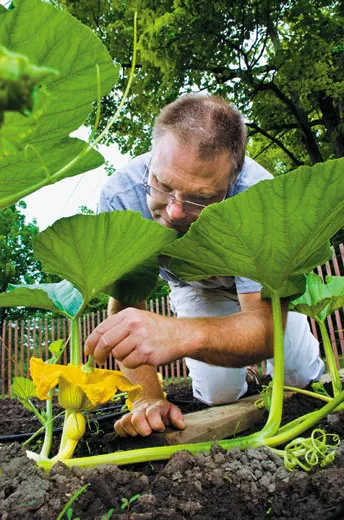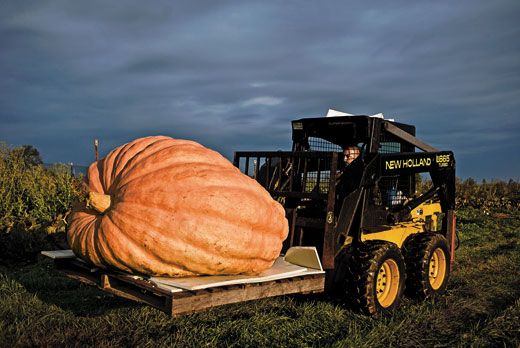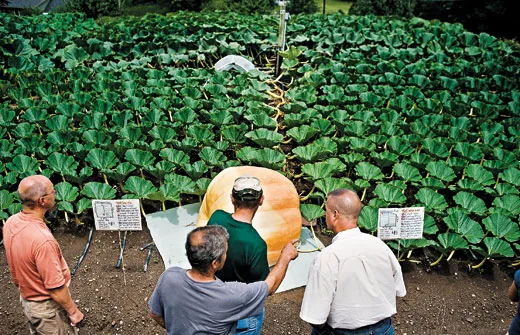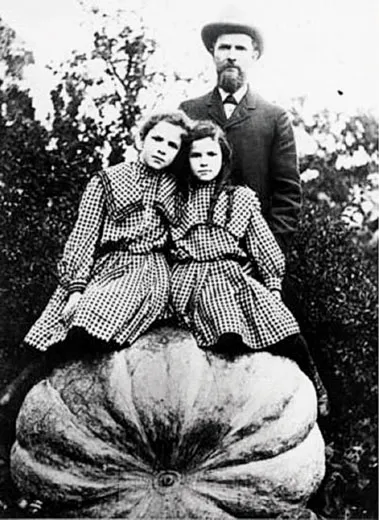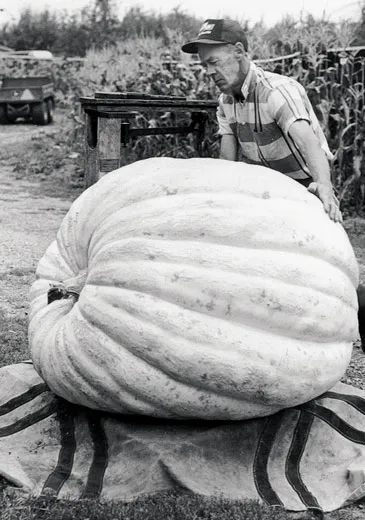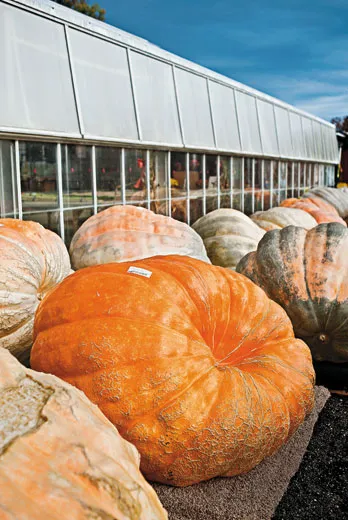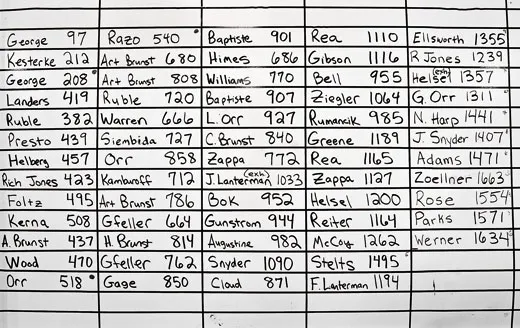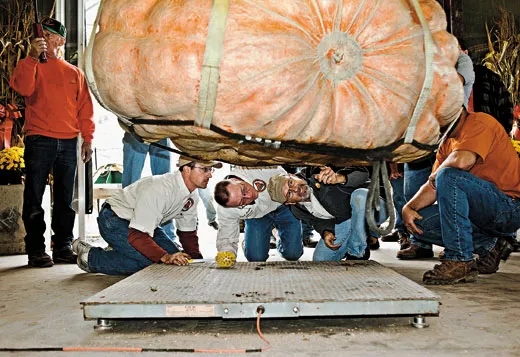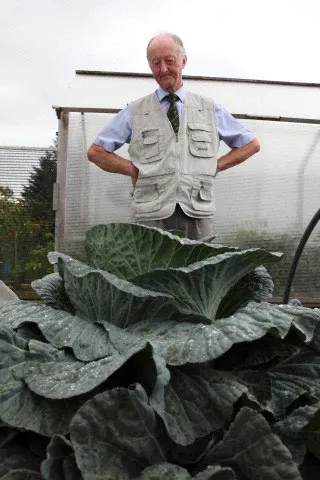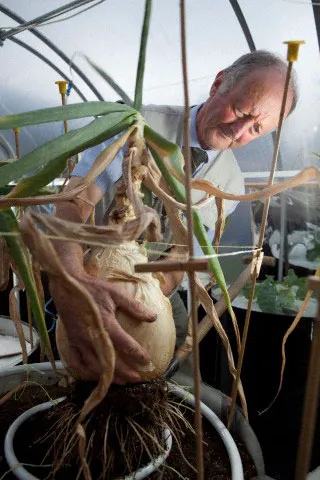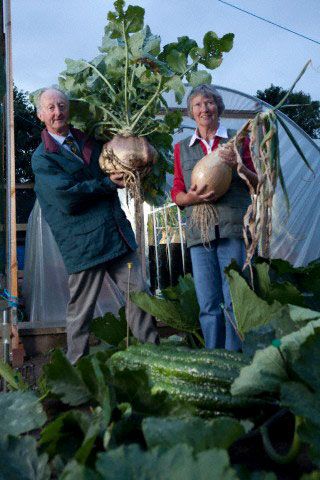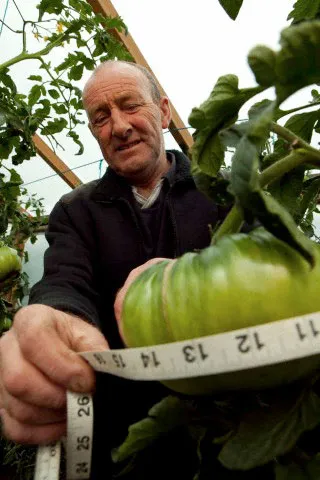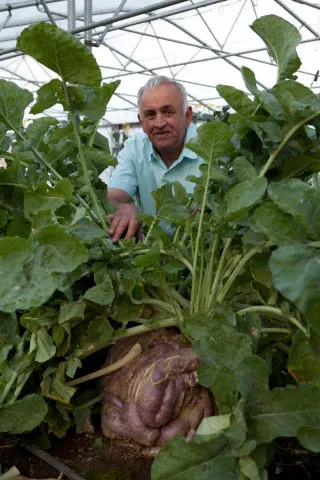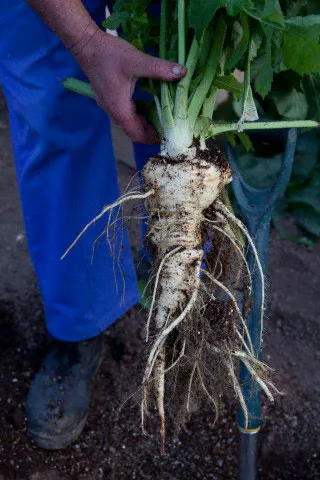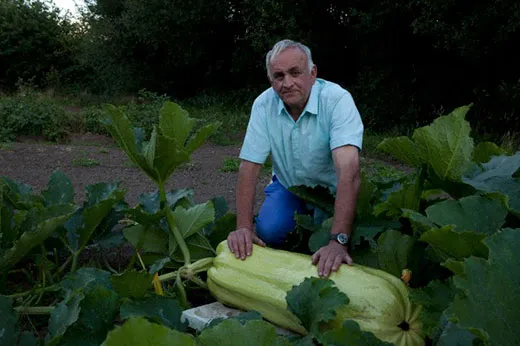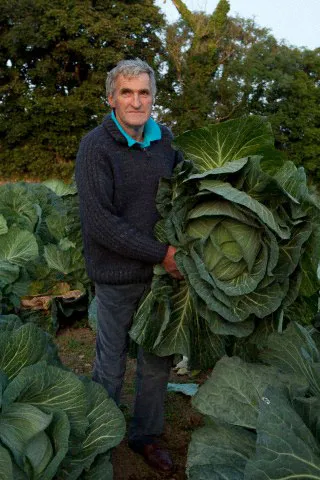The Great Pumpkin
Competitive vegetable growers are closing in on an elusive goal—the one ton squash
/https://tf-cmsv2-smithsonianmag-media.s3.amazonaws.com/filer/Competitive-vegetables-prize-pumpkin-631.jpg)
Quinn Werner’s backyard pumpkin patch overlooks a wooded creek. In the winter, when the maples and oaks stand like toothpicks and snow coats the western Pennsylvania valley, Werner gazes out his kitchen window and caresses his prizewinning seeds. The topsoil is frozen solid and his orange Kubota tractor gleams in the garage like a showroom floor model. He is not a big talker, but every Thursday his buddy Dave Stelts phones, and their conversation always comes back to springtime, to the patch and the weigh-off.
In April, Werner germinates his seeds, each one as long as a quarter, by soaking them in a mix of hydrogen peroxide and water. He pots them and incubates them in a cooler with heating pads.
He then places the seedlings under fluorescent lights upstairs in what he calls his pumpkin room. On nice days, he takes the little pots outside for an hour or two for fresh air and natural sunlight. In May, every seedling is planted in the patch under its own clear plastic tent fitted with incandescent bulbs that are switched on during chilly nights. Within weeks, the vines stretch out octopus-like from underneath the plastic. In June, when the first golden trumpets of female flowers begin to open, Werner brushes them with pollen-covered stamens from select male flowers and covers them with plastic foam cups to prevent honeybees from meddling with the pumpkin’s pedigree.
When I visited Werner’s property on a sweltering summer afternoon, he was checking his patch for the third time that day. Werner, 50, is a trim man with a gray beard, frameless glasses and a bald spot he often covers with a baseball cap. He straddled the orange mesh fence that surrounds his garden and waded through a sea of stiff, broad leaves toward a thigh-high dome covered by an old bedsheet. His 12 pumpkins had been growing for less than a month, so I had expected that one would be small enough to hoist into the back seat of a sedan. Werner whipped off the sheet, and there sat a shiny pale pumpkin (they turn orange later in the year) that seemed to sag on one side like a mound of Silly Putty left out in the sun. Based on its circumference, it was pushing 400 pounds, he estimated. And the season had just begun.
Werner beamed. “It’s real long and real wide,” he said. “It’s in really good shape.”
But as he leaned in closer, running his hand along a smooth ridge, his face grew taut. “Oh, man, as a matter of fact, it’s split.” Tucked into the blossom end of the pumpkin was a tiny crack. Even if the crack wasn’t enough to disqualify the fruit from competition (and it was), it would grow and provide access to bacteria that could quickly rot the pumpkin from the inside out. “That makes me sick,” he said. “This is the reason why I grow so many.” He sighed, recalling the axiom that Stelts has turned to in the face of such adversity: “If you’re not blowin’ them, you’re not growin’ them.”
Werner and Stelts are competitive gardeners who vie for bragging rights and prize money that ranges from a few hundred to thousands of dollars. Their crop of choice is the Atlantic Giant Pumpkin, a freak of nature and intensive breeding that is raised by thousands of growers around the world. During peak growing season, the pumpkin can bulk up by 50 pounds per day. At that rate, the fruit’s underside may curve into a concave shape, one of the many ways in which a glorious globe can split, shattering dreams of victory. The pumpkin Werner showed me that hot afternoon had suffered a crack after swelling too quickly after a hard rain. In general he has kept about two-thirds of his colossal calabazas intact. In 2008, he earned the title of “grower of the year” after trucking pumpkins to six weigh-offs and winning five of them with an average weight of nearly 1,500 pounds. “I lost by two pounds in the sixth,” he says.
Since the 1980s, giant pumpkins have tripled in size, thanks to strategic breeding and a new cadre of hard-core growers with time on their hands and dirt under their fingernails. (From April to October, Werner spends six to eight hours per day tending his garden.) Also, advances in soil science and technology have helped growers advance the frontiers of horticulture. Thomas Andres, a squash expert at the New York Botanical Garden, has predicted that the first 2,000-pound—one ton—pumpkin will appear in 2014.
Despite Werner’s dedication during the summer of 2010, he knew that a victory in the October pumpkin challenges would be far from certain. He would face the country’s best growers at the Ohio Valley Giant Pumpkin Growers Weigh-Off. In 2009, a schoolteacher named Christy Harp took home the title with a monster weighing 1,725 pounds. Stelts, who broke the world record in 2000 with a 1,140-pound pumpkin, had a couple of promising spheroids growing in his terraced patch an hour away. Werner was growing a few coveted seeds from a 1,421.5-pound pumpkin Stelts had harvested in 2009, but growers in Wisconsin, Michigan and other states had also obtained those seeds at club auctions or through trades.
The Ohio Valley contest, Werner’s local weigh-off, is one of more than 80 competitions in the “Great Pumpkin Belt,” which stretches across North America from Washington State to Nova Scotia. This is prime pumpkin territory—offering 90 to 120 frost-free summer days, but cold enough in winter to keep plant diseases and pests in check. The weigh-offs are friendly competitions, but they’re also a form of citizen science, with growers meticulously graphing their pumpkins’ growth curves and sharing success and failure with their peers.
“By God, if we can get a pumpkin up to a ton, imagine what we can do to somebody’s vegetable crop,” says Stelts, president of the Great Pumpkin Commonwealth, which oversees official weigh-offs. “What we are doing will be reflected on the dinner table of America.”
The path to prizewinning pumpkins can be traced, improbably, to Henry David Thoreau. In the spring of 1857, while living in Concord, Massachusetts, Thoreau planted six seeds from a French variety called Potiron Jaune Gros de Paris (fat yellow Paris pumpkin). He was astonished that fall when one fruit reached 123.5 pounds. “Who would have believed that there were 310 pounds of Potiron Jaune Grosse in that corner of my garden!” he wrote in Wild Fruits.
Thoreau’s hefty harvest was one of the first times a pumpkin of the Mammoth group, which includes today’s Atlantic Giants, made an appearance in North American gardens, according to seed sleuth Amy Goldman, author of The Compleat Squash. All pumpkins are squash, a loosely defined group of species in the family Cucurbitaceae, which includes melons, cucumbers and gourds. The field pumpkin (Cucurbita pepo) is the product of 8,000 years of selective breeding. The stuff of Halloween jack-o’-lanterns and homemade pumpkin pies, it is derived from the same Mexican stock as zucchini and spaghetti squash. Mammoths arise from a different squash species (Cucurbita maxima), a wild plant with a softball-size fruit that originated in South America, possibly near Buenos Aires. Giant ground sloths and elephant-like gomphotheres, both of which went extinct around 12,000 years ago, probably ate the large fruits and spread the plant’s seeds. Once domesticated, Mammoth squash passed through European hands before landing in Thoreau’s garden.
Unlike Pink Bananas, Hubbards and other C. maxima varieties savored by home gardeners for their flavor, competition Mammoths are prized for their size alone. Although groundhogs and other animals may chew holes in these giants, they are mostly water, not very tasty and often inedible. They range in color from pale yellow to mottled green and are rarely found on supermarket shelves.
Though large, Thoreau’s pumpkin hardly came close to the world record for 1857. That distinction went to a grower in southwest England whose fruit weighed in at 245 pounds. Other records followed over the years, but the watershed moment came from William Warnock, a machinist and farmer from Goderich, Ontario. In 1893, he produced a 365-pounder for the Chicago World’s Fair; seven years later, in Paris, his entry weighed 400 pounds. His next world record—403 pounds at the 1904 St. Louis World’s Fair—would hold for more than 70 years. “For exhibition purposes, it stands without a rival,” the 1924 Rennie Seed Company catalog noted of the lineage: “Skin dark green, flesh golden yellow.”
Warnock’s record was finally shattered in 1976 by a Pennsylvania grower, but it was a Canadian named Howard Dill who ushered in modern competitive gardening. Dill spent 30 years crossing Mammoth pumpkin varieties with one another, trying to isolate the best characteristics, such as a rich orange color. Beginning in 1979 Dill grew the world’s biggest pumpkin four years in a row, and he landed in the Guinness Book of World Records in 1981 for a 493.5-pounder. Today’s growers still use seeds descended from “Dill’s Atlantic Giant,” a variety he registered with the U.S. Department of Agriculture’s plant variety protection office in 1986. While other fruits, including the field pumpkin, long gourd and watermelon, have put on some serious pounds in recent years, none has matched the Atlantic Giant, which sets a new record nearly every year.
The Ohio Valley Giant Pumpkin Growers club, which includes members from four states, was always less cutthroat about competition than other groups, says Tim Parks, who co-founded the group in 1992. “Our whole attitude is that Ohio is one for all and all for one,” says Parks, a nurseryman who runs the annual weigh-off out of his office in Canfield.
From its early days the group has led seminars and patch tours at which experienced growers have shown newcomers the ropes. In 1995, Dave Stelts began attending club meetings with a yellow legal pad and scribbling down every word, redirecting what he calls his “obsessive-compulsive” tendencies into pumpkins. Stelts built a patch with drip lines laid out in parallel rows and installed an automated control room inside a wooden shed. Five years after attending his first club meeting, he set the world record.
In 2000, instead of driving his pumpkin to a weigh-off in New York State and netting a $10,000 bonus, he decided to stay in Ohio, where the prize money was only $1,500. “Not to be able to share it with all my friends would have been a crying shame,” he says.
On a rainy July day, Werner and Parks donned their monogrammed club shirts and crisscrossed the Ohio Valley with other club members on the annual patch tour. The two had seen a lot during their time with the club, but nothing prepared them for Jerry Snyder’s property in Bessemer, Pennsylvania. Snyder, a retired schoolteacher, sometimes devoted 12 hours a day to a garden that looked like a Hollywood set: Jurassic Park meets Little Shop of Horrors. Waxy green cabbage heads the diameter of basketballs ran along the edge of a patch filled with a dozen outsize onions poking out of the soil. Competition tomatoes the size of grapefruits, still green, dangled from vines near a bloated, pale orange pumpkin. Two six-foot-long gourds hung from a red arch. “Look at those petunias on the hillside there,” Parks said, enumerating the botanical riches from under an umbrella, “and those are raspberries and blackberries down there....He’s got the rhubarb up there...castor beans....This is a labor of love.”
Near a tent set up for tour members, Snyder was surrounded by two dozen growers in awe of his green thumb. “Is that leaf mulch one or two years old?” a club person asked.
“That’s last year’s, but I turn it four times,” he replied. The crowd gasped and murmured.
“You spray all your fertilizer on?” another asked. “You don’t run it through a drip line?”
“Nope. I spray it all.”
“What’s horticultural oil?”
“Baking soda and Joy dishwashing soap.”
“Is that safe to eat on zucchini?”
“All the farmers use it.”
A century ago, William Warnock fertilized his pumpkins with hen manure. Werner follows Warnock’s chicken-manure prescription, hauling out about 1,000 pounds every spring, but he’s more scientific. He rotates his pumpkin patch, growing sorghum in the summer in a patch he’s preparing for the next year. He plows under a winter crop of rye before planting his pumpkins. Both grasses have bacteria that pull nitrogen from the air and convert it to ammonia, enriching the soil. And as the vines creep along the bare ground in early summer, he scoops up a sandwich-bagful of dirt, plucks a few leaves and FedExes the material to John Taberna at Western Laboratories in Parma, Idaho. After Taberna told Werner that his pumpkins lacked magnesium and manganese, Werner began spraying them with a chelated fertilizer. Werner also adds his own microorganisms to the soil.
Scientists have long recognized the degree to which plants depend on microbes to obtain nutrients, but that knowledge has been applied only in limited ways in agriculture. In areas that have been devastated by wildfires or strip mining, some government agencies spray mycorrhizal fungi on seedlings or blend it into the soil to improve tree survival and growth. The practice broke into competitive pumpkin growing in 2005, when a Rhode Islander named Ron Wallace phoned Reforestation Technologies International, a Salinas, California, plant nutrient company, and asked to test its commercial mycorrhizal product. “I’ll give you 20 pounds, but if you win any prizes, I want bragging rights,” said company president Neil Anderson. Sure enough, Wallace went on to break the pumpkin world record in 2006, and Anderson began marketing Xtreme Gardening products a few years later, to which he recently added the nitrogen-fixing bacteria Azospirillum. “Bacteria are miniature fertilizer factories,” he says.
Today, all the top growers use soil organisms, often from Anderson’s company or Holland’s Land O’Giants, a Sumner, Washington, company run by grower Joel Holland. Carolyn Scagel, a plant physiologist at the U.S. Department of Agriculture in Corvallis, Oregon, says Azospirillum and mycorrhizae can increase fertilizer efficiency and decrease plants’ susceptibility to pathogens, but only if the added strains are compatible with the plant and soil conditions. Whether generic mycorrhizae in commercial products help Ohio’s well-fertilized gardens is anyone’s guess. The growers say their pumpkins aren’t getting any smaller.
All of which raises the question of just how much larger they can get. “Nobody knows what the limit is going to be,” says Andres, of the New York Botanical Garden. In fact, mechanical engineer David Hu and colleagues at the Georgia Institute of Technology have been investigating pumpkin growth. A world-record strawberry or tomato weighs about ten times the average, they found. By contrast, giant pumpkins weigh 100 times the average. And Hu thinks they can get even bigger. To figure out how much bigger, he and his colleagues placed pumpkins of various sizes in a vise-like instrument and subjected the fruits to pressure until they cracked. These force measurements led them to estimate just how big a pumpkin might get in a perfect world. The answer: 20,000 pounds. Of course, real pumpkins with their warts, scars and dimples are unlikely to ever come close to geometrical perfection. A 1,000-pound pumpkin may have a wall that’s 16 inches thick on one side and one inch on the other, a recipe for disaster, or at least a very large pumpkin pie.
By early September, the top pumpkins have crossed the 1,500-pound threshold, and growers grow tight-lipped. Yet word about the contenders always seems to get out, spreading like a vine from Nova Scotia to Washington State. In 2010, record temperatures pushed the focus of the competition to latitudes normally too far north to produce winners. “There’s probably at least six or seven that have a chance to break the world record,” Werner told me one evening, sharing rumors about giants in Michigan and New Hampshire he’d picked up at BigPumpkins.com, the go-to spot for pumpkin gossip. “Tim Parks has a decent one,” he noted, quickly adding, “that’s not information that he wants anybody to know.”
On the day before the Canfield weigh-off last October, a cold front blew in from the north, drenching much of the East in heavy rains and causing the first tawny leaves of autumn to fall. I got to Werner’s farm in the late afternoon in time to watch him and his son Matt hoist their largest pumpkin—grown from that promising “1421 Stelts” seed—onto a trailer.
The knee-high jungle I’d seen in the summer now had a tattered look about it. Leaves were yellowing and fraying. In the last month, pumpkins put on fewer than five pounds per day, and growers worry about their prize remaining intact until the weigh-off. It’s at this point that some of the worst mishaps occur, such as the discovery of a soft spot on the pumpkin’s bottom or a miscalculation during loading.
For Werner, this was the moment of truth—a scale mounted to fork tines of his tractor would tell him what he had. The weights he’d been estimating all season could be off by 25 percent, and many a promising pumpkin has “gone light.” Matt pulled a lever on the tractor, and the fork rose, pulling taut the eight straps that encircled the pumpkin. Quinn Werner glanced down at the digital readout. “Not a world record,” he muttered. The pumpkin had gone light.
That didn’t mean he wasn’t going to make the other growers sweat a little. He wrapped the 1,634-pound fruit with water-soaked towels and cellophane, to minimize evaporation, and taped a bag of water to the freshly cut stem. “If anyone asks, I’ll say it’s my secret juice,” he joked.
To the west, in New Richmond, Wisconsin, a 33-year-old grower named Chris Stevens had used a flower from a 1421 Stelts to pollinate a plant from New Hampshire. Stevens estimated the fruit at 1,541 pounds, but at the 2010 Stillwater Harvest Fest, in Minnesota, it came in at 1,810.5 pounds, a new world record. A Michigan grower came in second. Even South Dakota made the top five.
With climate change, the Great Pumpkin Belt could widen, giving the Ohio Valley stiffer competition from the north, says Andres. Stevens is doubtful that such northerly states are going to overtake Ohio Valley’s lead any time soon. “That’s the number-one weigh-off in the world,” he said reverently. “They have a good chance of holding onto it.”
At the Canfield weigh-off, Tim Parks grabbed a microphone and addressed the audience: “It’s a deep-rooted tradition—gardening in our society—and this is the max of it!”
Under a gray sky, Werner’s pumpkin sat next to Jerry Rose’s, which sat next to Parks’, and there was Dave Stelts’ mottled green beast, his only survivor of a tough season. They were lined up based on their circumferences, but the number-four pumpkin—a 1,663-pound globe brought by a dark horse Ohio grower named Jeff Zoellner—earned the top prize. “I was worried about Tim and Jerry,” said Werner, who came in second. “I wasn’t expecting this at all.”
Overall, officials weighed 63 pumpkins, and at the end of the day Ohio Valley remained the heaviest site in the world, with its top ten pumpkins averaging 1,490.2 pounds.
Quinn Werner was already thinking about the pumpkins he would grow next year.
Brendan Borrell has written about chili peppers and cassowaries for Smithsonian. Greg Ruffing lives in Chicago.
